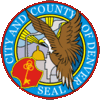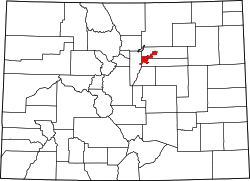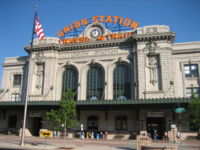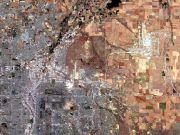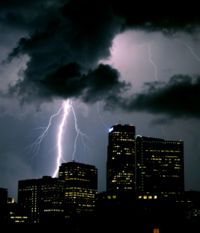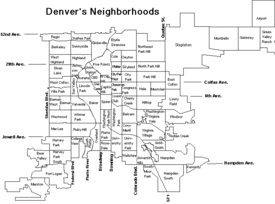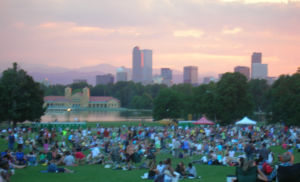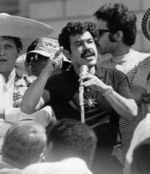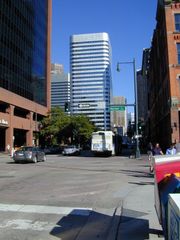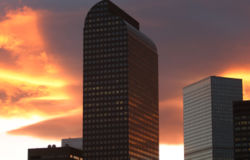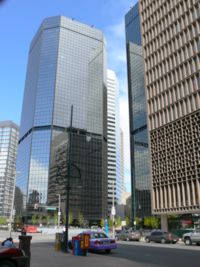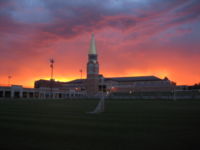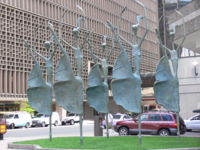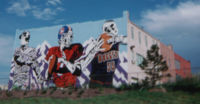Denver, Colorado
2007 Schools Wikipedia Selection. Related subjects: North American Geography
| Denver, Colorado | |||||
|
|||||
| Nickname: "The Mile-High City" | |||||
| Location of Denver in Colorado, USA | |||||
| Coordinates: | |||||
|---|---|---|---|---|---|
| Country | United States | ||||
| State | Colorado | ||||
| City-County | Denver (coextensive) | ||||
| Founded | November 22, 1858 | ||||
| Incorporated | November 7, 1861 | ||||
| Mayor | John Hickenlooper ( D) | ||||
| Area | |||||
| - City | 401.3 km² (154.9 sq mi) | ||||
| - Land | 397.2 km² (153.3 sq mi) | ||||
| - Water | 4.1 km² (1.6 sq mi) | ||||
| Elevation | 1,609 m (5280 ft) | ||||
| Population | |||||
| - City (2006) | 557,917 | ||||
| - Density | 1,405/km² (3,639/sq mi) | ||||
| - Metro | 2,330,146 | ||||
| Time zone | MST ( UTC-7) | ||||
| - Summer ( DST) | MDT ( UTC-6) | ||||
| Website: www.denvergov.org | |||||
The City and County of Denver is the most populous city, the second most populous county, and the capital of the State of Colorado. Denver is located in the South Platte River Valley on the High Plains just east of the Front Range of the Southern Rocky Mountains. The Denver downtown district is located immediately east of the confluence of Cherry Creek with the South Platte River, approximately 15 miles (24 kilometers) east of the foothills of the Rocky Mountains. Denver has a consolidated city and county government. Residents of Denver are known as Denverites.
The United States Census Bureau estimates that in 2005 the population of the City and County of Denver was 557,917 (25th most populous U.S. city), the population of the Denver-Aurora Metropolitan Statistical Area was 2,359,994 (22nd most populous MSA), and the population of the Denver-Aurora-Boulder Combined Statistical Area was 2,869,377 (19th most populous CSA). Denver is the most populous city within a radius of 550 miles (885 kilometers), and the Denver Metropolitan Area is the most populous in the Rocky Mountain Region of North America. The city claims to have the 10th largest downtown district in the United States.
Denver is nicknamed "The Mile-High City" because its official elevation, engraved on the fifteenth step of the state capitol building, is one statute mile (5280 feet or 1609 meters) above sea level. The elevation of Denver International Airport is 5431 feet (1655 meters).
Denver has also been known historically as the Queen City of the Plains because of its important role in the agricultural industry of the plains regions along the foothills of the Front Range. Other nicknames that Denver has had include The Rail City, for the city's importance as a North American rail hub, and Capital of the Rocky Mountain Empire, for the city's preeminence in the Rocky Mountain region. Several US Navy ships have been named USS Denver in honour of the city.
History
Denver was founded in the Kansas Territory in 1858. That summer a group from Lawrence, Kansas, arrived and established Montana City on the banks of the South Platte River. This was the first settlement in what was later to become the city of Denver. The site faded quickly, however, and was abandoned in favour of Auraria and St. Charles City by the summer of 1859. The site is now Grant-Frontier Park and includes mining equipment and a log cabin replica.
On November 22, 1858, General William Larimer, a land speculator from eastern Kansas, placed cottonwood logs to stake a claim on the hill overlooking the confluence of the South Platte River and Cherry Creek, across the creek from the existing mining settlement of Auraria. Larimar named the townsite Denver City in honour of Kansas Territorial Governor James W. Denver. Larimer hoped that the town's name would help make it the county seat of Arapaho County, but ironically Governor Denver had already resigned from office. The location was accessible to existing trails and was across the South Platte River from the site of seasonal encampments of the Cheyenne and Arapaho. The site of these first towns is now the site of Confluence Park in downtown Denver. Larimer, along with associates in the St. Charles City Land Company, sold parcels in the town to merchants and miners, with the intention of creating a major city that would cater to new emigrants. Denver City was a frontier town, with an economy based on servicing local miners with gambling, saloons, livestock and goods trading. In the early years, land parcels were often traded for grubstakes or gambled away by miners in Auraria.
The Colorado Territory was created on February 28, 1861, Arapahoe County was formed on November 1, 1861, and Denver City was incorporated on November 7, 1861. Denver City served as the Arapahoe County Seat until 1902. In 1865, Denver City became the Territorial Capital, and on August 1, 1876, Denver (no longer needing to call itself Denver City) became the State Capital when Colorado was admitted to the Union.
Between 1880-1895 the city experienced a huge rise in city corruption, as crime bosses, such as Soapy Smith, worked side-by-side with elected officials and the police, to control the elections, gambling, and the bunko gangs. By 1890, Denver had grown to be the second largest city west of Omaha, Nebraska, second only to San Francisco. It would lose the title at the turn of the century to Los Angeles, however. In 1887, the precursor to the international charity United Way was formed in Denver by local religious leaders who fundraised and coordinated various charities to help Denver's poor.
The era of the 1890s played an important role in Denver's history, as this is when the city began to take on a "big city" image. On November 15, 1902, Arapahoe County was split into the new consolidated City and County of Denver, the new Adams County, and the renamed South Arapahoe County. The 1908 Democratic National Convention was staged to promote Denver's prominence, and to signify the city's participation on the national political and socioeconomic stage.
Denver was selected to host the 1976 Winter Olympics to coincide with Colorado's centennial anniversary, but Colorado voters struck down ballot initiatives allocating public funds to pay for the high costs of the games, so they were moved to Innsbruck, Austria. The infamy of becoming the only city ever to decline to host an Olympiad after being selected has made subsequent bids difficult. The movement against hosting the games was based largely on environmental issues and was led by then State Representative Richard Lamm. Lamm was subsequently elected as Colorado governor in 1974. Beat icon Neal Cassady was raised on Larimer Street in Denver, and a portion of Jack Kerouac's beat masterpiece On the Road takes place in the city, and is based on the beat's actual experiences in Denver during a road trip. Beat poet Allen Ginsberg lived for a time in the Denver suburb of Lakewood, and he helped found the Buddhist college, Naropa University or the "Jack Kerouac School of Disembodied Poetics at Naropa" in nearby Boulder.
Geography
Denver is located at GR1 in the Colorado Front Range region, between the Rocky Mountains to the west and the Great Plains to the east. According to the United States Census Bureau, the city has a total area of 401.3 km² (154.9 mi²), of which 4.1 km² (1.6 mi²), or 1.03%, is water.
Adjacent Counties
- Adams County, Colorado - north and east
- Arapahoe County, Colorado - south and east and southeastern enclaves
- Jefferson County, Colorado – west
Climate
Denver has a semi-arid climate with four distinct seasons. While Denver is located on the Great Plains, the weather of the city and surrounding area is heavily influenced by the proximity of the Rocky Mountains to the west. The climate, while generally mild compared to the mountains to the west and the plains further east, can be very unpredictable. Measurable amounts of snow have fallen in Denver as late as Memorial Day and as early as Labor Day, and trace amounts have been recorded in every month of the year.
The average temperature in Denver is 50.1 °F (10.1 °C), and the average yearly precipitation is 15.81 in (402 mm). The season's first snowfall generally occurs around October 19, and the last snowfall is about April 27, averaging 61.6 in (156 cm) of seasonal accumulation. Although Denver's Convention and Visitor Bureau claims Denver receives over 300 sunny days a year, the National Oceanic and Atmospheric Administration places that figure at about 250 days of sunshine a year.
Denver's winters can vary from mild to cold, and although large amounts of snow can fall on the mountains just west of the city, the effects of orographic lift dry out the air passing over the Front Range, shadowing the city from precipitation for much of the season. Additionally, warm chinook winds can occasionally be felt as air passing over the mountains heats as it descends. Nevertheless, winters are generally mild, with the coldest temperature ever recorded in Denver was recorded on January 9, 1875 at -29 °F (-34 °C), though the last time Denver recorded a temperature below -20 °F (-29 °C) was in 1990.
Spring brings with it significant changes as Denver can be affected by air masses on all sides, whether arctic air from the north, which occasionally combines with Pacific storm fronts bringing snow to the city. In fact, March is Denver's snowiest month, averaging 11.7 in (29.7 cm) of snow. Additionally, warm air from the Gulf of Mexico can bring the first thunderstorms of the season, and continental warm air can bring summer-like warm and dry conditions.
Starting in mid-July, the monsoon brings tropical moisture into the city and with it come frequent short (and occasionally severe) late-afternoon thunderstorms. However, despite this tropical moisture, humidity levels during the day generally remain very low. The average high during the summer is 85 °F (29 °C) and the average low is 56 °F (13 °C).
In the autumn, the tropical monsoon flow dies down and as arctic air begins to approach, it can combine with moisture from the Pacific Northwest to bring significant snowfall to the city – November is Denver's second snowiest month, and Denver's greatest recorded snowfall from a single storm, 45.7 in (116 cm), fell in late autumn from December 1 to December 6, 1913.
|
|
|
Jan | Feb | Mar | Apr | May | Jun | Jul | Aug | Sep | Oct | Nov | Dec |
|---|---|---|---|---|---|---|---|---|---|---|---|---|---|
| Extreme Daily Maximum | °F | 76 | 77 | 84 | 90 | 95 | 104 | 105 | 105 | 97 | 90 | 80 | 79 |
| Average Daily Maximum | °F | 43 | 47 | 54 | 61 | 71 | 82 | 88 | 86 | 77 | 66 | 52 | 44 |
| Average Daily Minimum | °F | 15 | 19 | 25 | 34 | 44 | 53 | 59 | 57 | 47 | 36 | 24 | 16 |
| Extreme Daily Minimum | °F | -29 | -25 | -11 | -2 | 19 | 30 | 42 | 40 | 17 | -2 | -18 | -25 |
| Data recorded from Downtown Denver (1872-1949), Stapleton Airport (1950-2/95), and Denver International Airport (Since 3/95). Averages 1971-2000. | |||||||||||||
|
|
|
Jan | Feb | Mar | Apr | May | Jun | Jul | Aug | Sep | Oct | Nov | Dec |
|---|---|---|---|---|---|---|---|---|---|---|---|---|---|
| Average Precipitation | in | 0.51 | 0.49 | 1.28 | 1.93 | 2.32 | 1.56 | 2.16 | 1.82 | 1.14 | 0.99 | 0.98 | 0.63 |
| Average Snowfall | in | 7.7 | 6.3 | 11.7 | 9.1 | 1.3 | T | 0.0 | 0.0 | 2.1 | 4.1 | 10.7 | 8.7 |
| Precipitation data recorded from Stapleton Airport (1971-2/95), and Denver International Airport (3/95-2000). Snowfall data recorded from Stapleton Airport (1971-2000). Averages 1971-2000. | |||||||||||||
Neighborhoods
Denver has 79 neighborhoods that the city and community groups use for planning and administration. Although the city's delineation of the neighbourhood boundaries is somewhat arbitrary, it corresponds roughly to the definitions used by residents. These "neighborhoods" should not be confused with cities or suburbs, which are separate entities within the metro area.
These neighborhoods' character vary significantly from each other and include everything from large skyscrapers to turn of the 20th century houses to modern, suburban style developments. Generally, the neighborhoods closest to the city center are denser, older and contain more brick building material. Many neighborhoods away from the city center were developed after World War II, and are built with more modern materials and style. Some of the neighborhoods even further from the city centre, or recently redeveloped parcels anywhere in the city have either very suburban characteristics or are new urbanist developments that attempt to recreate the feel of older neighborhoods. Most neighborhoods contain parks or other feature that is the focal point for the neighbourhood.
Denver also has a number of neighborhoods not reflected in the administrative boundaries. Sometimes, these neighborhoods reflect the way people in an area identify themselves; sometimes, they reflect how others, such as real estate developers, have defined those areas.
Well-known neighborhoods include the historic and trendy LoDo (short for "Lower Downtown"), part of the city's Union Station neighbourhood; Capitol Hill, Highland, Washington Park; Uptown, part of the North Capitol Hill neighbourhood; Curtis Park, part of the Five Points neighbourhood; Alamo Placita, the northern part of the Speer neighbourhood; and Golden Triangle, in the Civic Centre.
Parks and recreation
When Denver was founded in 1858, the city was little more than a dusty collection of buildings on a long, grassy plain with a few contorted cottonwood and willow trees on riverbanks. As of 2006, Denver has over 200 parks, from small mini-parks all over the city to the giant 314 acre (1.3 km²) City Park to the 14,000 acre (57 km²) Denver Mountain Parks. Denver also has 28 recreation centers providing places and programming for resident's recreation and relaxation.
Many of Denver's parks were acquired from state lands in the late 19th and early 20th centuries. This coincided with the City Beautiful movement, and legendary Denver mayor Robert Speer (1904-12 and 1916-18) set out to expand and beautify the city's parks. Reinhard Schuetze was the city's first landscape architect, and he brought his German-educated landscaping genius to Washington Park, Cheesman Park, and City Park among others. Speer used Schuetze as well as other landscape architects such as Frederick Law Olmsted, Jr. and Saco Rienk DeBoer to design not only parks such as Civic Centre Park, but many city parkways and tree-lawns. All of this greenery was fed with South Platte River water diverted through the city ditch.
In addition to the parks within Denver itself, the city acquired land for mountain parks starting in the 1910s. Over the years, Denver has acquired, built and maintained around 40,000 acres (160 km²) of mountain parks, the most famous being Red Rocks Park, which is known just as much for its scenery as its musical history revolving around the Red Rocks Amphitheatre. Denver also owns the Winter Park Resort ski area in Grand County, 60 miles west of Denver. City parks are important places for the both Denverites and visitors inciting controversy with every change. Denver continues to grow its park system with the development of many new parks along the Platte River through the city and in the Stapleton neighbourhood redevelopment. All of these parks are important gathering places for residents and allow what was once a dry plain to be lush, active, and green.
Demographics
| Denver Population by Year |
|
| 1880 | 35,629 |
| 1890 | 106,713 |
| 1900 | 133,859 |
| 1910 | 213,381 |
| 1920 | 256,491 |
| 1930 | 287,861 |
| 1940 | 322,412 |
| 1950 | 415,786 |
| 1960 | 493,887 |
| 1970 | 514,678 |
| 1980 | 492,365 |
| 1990 | 467,610 |
| 2000 | 554,636 |
| 2005 | 557,917 |
According to 2005 census GR2, the metropolitan MSA population of the Denver-Aurora area is 2,359,994. The City and County of Denver contains approximately 545,198 people, 250,906 households, and 119,378 families reside in the city. The population density is 1,396.5/km² (3,616.8/mi²). There are 268,617 housing units at an average density of 633.1/km² (1,639.6/mi²).
The racial makeup of the city is 51.9% White, 11.1% Black or African American, 2.81% Asian American, 2.20% Native American, 0.12% Pacific Islander, 15.59% from other races, and 3.75% from two or more races. 31.68% of the population is Hispanic or Latino of any race.
There are 250,906 households, out of which 23.2% have children under the age of 18 living with them, 34.7% are married couples living together, 10.8% have a female householder with no husband present, and 50.1% are non-families. 39.3% of all households are made up of individuals and 9.4% have someone living alone who is 65 years of age or older. The average household size is 2.27 and the average family size is 3.14.
In the city, the population is spread out with 22.0% under the age of 18, 10.7% from 18 to 24, 36.1% from 25 to 44, 20.0% from 45 to 64, and 11.3% who are 65 years of age or older. The median age is 33 years. For every 100 females there are 102.1 males.
The median income for a household in the city is $39,500, and the median income for a family is $48,195. Males have a median income of $34,232 versus $30,768 for females. The per capita income for the city is $24,101. 14.3% of the population and 10.6% of families are below the poverty line. Out of the total population, 20.3% of those under the age of 18 and 9.7% of those 65 and older are living below the poverty line.
Government
Denver is a consolidated city and county with a non-partisan elected mayor (though s/he may belong to a particular political party), a 13-member city council and an auditor. The Denver City Council is elected from 11 districts with two at-large council-members and is responsible for passing and changing all laws, resolutions, and ordinances, usually after a public hearing. They can also call for misconduct investigations of Denver's departmental officials.
Denver has a strong mayor/weak city council government. The mayor can approve or veto any ordinances or resolutions approved by the council, makes sure all contracts with the city are kept and performed, signs all bonds and contracts, is responsible for the city budget, and can appoint people to various city departments, organizations, and commissions. However, the council can override the mayor's veto with a nine out of 13 member vote, and the city budget must be approved and can be changed by a simple majority vote of the council. The auditor checks all expenditures and may refuse to allow specific ones, usually based on financial reasons.
All elected officials have four-year terms, with a maximum of two terms. While Denver elections are non-partisan, Democrats have long held a virtual monopoly on Denver politics with all elected officials having Democratic Party affiliation. In federal elections, Denverites also tend to vote for Democratic candidates, voting for the Democratic Presidential nominee in every election since 1960 (excluding 1980 and 1972). The office of Denver's Mayor has been occupied by a Democrat since the municipal general election of 1963, including the current mayor, John Hickenlooper. Denver is represented at the federal level by congresswoman Diana DeGette, a Democrat representing Colorado's 1st congressional district, which includes all of Denver and parts of Arapahoe County.
During the 1960s and 1970s, Denver was one of the epicenters of the Chicano Movement. The boxer-turned-activist Rodolfo "Corky" Gonzales formed an organization called the Crusade for Justice, which battled police brutality, fought for bilingual education, and, most notably, hosted the First National Chicano Youth Liberation Conference in March of 1969.
In recent years, Denver has taken a stance on helping people who are or become homeless, particularly under the administrations of mayors John Hickenlooper and Wellington Webb. Denver's homeless population is considerably lower than many other major cities, but residents of the city streets have suffered during Denver's winters. Although mild and dry much of the time, Denver's winters can have brief periods of cold temperatures and varying amounts of snow. As a result, the city has set a national precedent on homeless services, with the creations of a ten-year plan to end homelessness (a plan now becoming popular in other cities as well), a task force and commission to end homelessness, and an expansion of human and civil services through the Denver area.
In 2005, Denver became the first major city in the U.S. to make the private use of less than an ounce of marijuana legal for adults 21 and older. The city voted 53.49%-46.51% in favour of the marijuana legalization measure. It should be noted that this initiative does not usurp state law, which currently treats marijuana possession in much the same way as a speeding ticket, with fines of up to $100 and no jail time. The electorate of Colorado voted on and rejected a similar state-wide initiative in November 2006.
Denver is competing with New York to host the 2008 Democratic National Convention, which would coincidentally be the centennial of the city's first hosting of the landmark 1908 convention. It also hosted the G7 (now G8) summit between June 20 and June 22 in 1997.
Economy
Denver's economy is based partially on its geographic position and its connection to some of the major transportation systems of the country. Because Denver is the largest city within 600 miles, it has become a natural location for storage and distribution of goods and services to the Mountain States. Denver is also approximately halfway between the large cities of the Midwest like Chicago and Detroit and the cities of the West Coast, another benefit for distribution. Over the years, the city has been home to some large corporations in the central United States, making Denver a key trade point for the country.
Geography also allows Denver to have a considerable government presence, with many federal agencies based or having offices in the Denver area. In fact, the Denver-Aurora Metropolitan Area has more federal workers than any other metropolitan area except for the Washington D.C. metropolitan area. Along with the plethora of federal agencies come many companies based on US defense and space projects. Lockheed-Martin and Ball Aerospace are examples. Being the capital of the state of Colorado also gives many state jobs to Denver.
In 2005, an expansion for the Colorado Convention Centre was completed. According to local officials, the convention centre expansion makes the city one of the top 10 cities in the nation for holding a convention.
Denver's position near the mineral-rich Rocky Mountains, encouraged mining and energy companies to spring up in the area. In the early days of the city, gold and silver booms and busts played a large role in the economic success of the city. In the 1970s and early 1980s, the energy crisis in America created an energy boom in Denver captured in the soap opera Dynasty. During this time, Denver was built up considerably, with many new downtown skyscrapers built during this time. Eventually, the oil prices dropped from $34 a barrel in 1981 to $9 a barrel in 1986, and the Denver economy dropped with it, leaving almost 15,000 oil industry workers in the area unemployed (including current mayor John Hickenlooper, a former geologist), and the highest office vacancy rate in the nation (30%). Energy and mining are still important in Denver's economy today, with companies such as EnCana, Halliburton, Newmont Mining, Nobel Energy, and Anadarko.
Denver's west-central geographic location in the Mountain Time Zone (UTC -7) also benefits the telecommunications industry by allowing communication with both North American coasts, South America, Europe, and Asia in the same business day. Denver's location on the 105th meridian at over 1 mile in elevation also enables it to be the largest city in the U.S. to offer a 'one-bounce' real-time satellite uplink to six continents in the same business day. Qwest Communications, EchoStar, Starz-Encore, and Comcast are just a few of the telecommunications companies with operations in the Denver area. These and other high-tech companies had a boom in Denver in the mid to late 1990s, but the technology bust in the new millennium caused Denver to lose many of those technology jobs. Recently, the Denver area has started making a comeback, with the October 2005 unemployment at 4.7% the lowest since September of 2001. Denver government and industry leaders are attempting to diversify the Denver economy so that it is less susceptible to boom and bust cycles.
Transportation
Grid system
Most of Denver has a straightforward street grid oriented to the four cardinal directions. Blocks are usually identified in hundreds from the median streets, identified as "0", which are Broadway (the west-east median) and Ellsworth Avenue (the north-south median). Colfax Avenue, the major east-west artery through Denver, is 15 blocks (1500) north of the median. Avenues north of Ellsworth are numbered (with the exception of Colfax Avenue and a few others), while avenues south of Ellsworth are named.
There is also an older downtown grid system that was designed to be parallel to the confluence of the South Platte River and Cherry Creek. Most of the streets downtown and in LoDo run northeast-southwest and northwest-southeast. This system has an unplanned benefit for snow removal; if the streets were in a normal N-S/E-W grid, only the N-S streets would receive sunlight. With the grid oriented to the diagonal directions, the NW-SE streets receive sunlight to melt snow in the morning and the NE-SW streets receive it in the afternoon. The NW-SE streets are numbered, while the NE-SW streets are named. The named streets start at the intersection of Colfax Avenue and Broadway with the block-long Cheyenne Place. The numbered streets start underneath the Colfax and I-25 viaducts. There are 27 named and 44 numbered streets on this grid. There are also a few vestiges of the old grid system in the normal grid, such as Park Avenue, Morrison Road, and Speer Boulevard.
All roads in the downtown grid system are streets. ( 16th Street, Stout Street) Roads outside of that system that travel east/west are given the suffix "avenue" and those that head north and south are given the "street" suffix. (Example, Colfax Avenue, Lincoln Street,). Boulevards are higher capacity streets and will travel any direction. Smaller roads are sometimes referred to as places, drives or courts. Most streets outside of the area between Broadway and Colorado Boulevard are organized alphabetically from the city's centre.
Confusion may arise where the two grid systems meet, especially given downtown Denver's one way streets. The system can be easily navigated with the help of directional signs. The mountains to the west also offer a great compass-point for those attempting to drive in the Mile High City.
Highways
Denver is primarily served by the interstate highways I-25 and I-70. The intersection of the two interstates is referred to locally as " the mousetrap", because when airborne, the junction (and subsequent vehicles) resemble mice in a large trap. I-70 runs east-west from Utah to Maryland. I-25 runs north-south from New Mexico through Denver to Wyoming. I-225 traverses neighboring Aurora and connects with I-25 in the southeastern corner of Denver. Additionally, I-76 begins from I-70 just west of the city in Arvada. It intersects I-25 north of the city and runs northeast to Nebraska where it ends at I-80. U.S. Route 6 connects downtown Denver to the suburb of Golden.
A highway expansion and transit project for the southern I-25 corridor, dubbed T-REX (TRansportation EXpansion), was completed on November 17th, 2006. The project installed wider and additional highway lanes, and improved highway access and drainage. The project also includes a light rail line that traverses from downtown to the south end of the metro area, known as "Surrey Ridge". The project spanned almost 19 miles along the highway with an additional line traveling parallel to part of I-225
Mass transportation
Mass transportation throughout the Denver-Aurora metropolitan area is managed and coordinated by the Regional Transportation District (RTD). RTD currently operates more than 1,000 buses serving 10,000 bus stops in 38 municipal jurisdictions. Additionally, RTD operates two light rail lines (the C Line and the D Line) with a total of 15.8 miles of track and serving 24 stations. Current RTD local fare is $1.50 with disabled residents who have an RTD disabled discount card being charged 75¢. FasTracks, an expansion project approved by voters in 2004, will allow light rail to serve cities such as Lakewood, Golden, and Aurora. Commuter rail lines will serve the northern section of the metropolitan area, in addition to Boulder, Longmont, and Denver International Airport. November 17, 2006 the first extension of Light Rail in four years, and some elements of the new lines will mark the beginning of the FasTracks program (although this extension of the system was part of T-Rex). The E and F Lines travel from downtown Denver to Lincoln Avenue, at the southern end of the Metro area. The H Line travels from downtown Denver to the Nine Mile station, on I-225 in Aurora. The G line, the shortest line in the extension, travels from Lincoln Avenue to the Nine Mile station.
Amtrak, the national passenger rail system, provides service to Denver, operating its California Zephyr daily in both directions between Chicago and Emeryville, California, across the bay from San Francisco. Amtrak Thruway service operated by private bus companies links the Denver station with Rocky Mountain points. At Raton, New Mexico, Denver Thruway connections are made daily with the Amtrak Southwest Chief. Additionally, there is the Ski Train operated by the Denver & Rio Grande Western Railroad, which takes passengers between Denver and the Winter Park Ski Resort. Denver's early years as a major train hub of the west are still very visible today. Trains stop in Denver at historic Union Station, where travelers can access RTD's 16th Street Free MallRide or use light rail to tour the city. Union Station will also serve as the main juncture for rail travel in the metro area, at the completion of FasTracks.
Airports
Denver International Airport (IATA: DEN, ICAO: KDEN), commonly known as DIA, serves as the primary airport for the Denver-Aurora Metropolitan area. It is the eleventh busiest airport in the world and ranks sixth in the United States, with 43.4 million passengers passing through it in 2005. It covers more than 53 square miles (137 km²), making it the largest airport in the United States by land area. Denver serves as a major hub for United Airlines and the headquarters for Frontier Airlines. In the past, Denver has been home to other airports that are no longer operational. Stapleton International Airport was closed in 1995 when it was replaced by DIA. Lowry Air Force Base was a military flight training facility that ceased flight operations in 1966, with the base finally being closed in 1994.
Education
Colleges and universities
Denver's many colleges and universities range in age and study programs. The city boasts Roman Catholic and Jewish institutions, as well as a well-respected health sciences school. In addition to those schools within the city, there are a number of schools located throughout the surrounding metro area.
- University of Denver
- Metropolitan State College of Denver
- University of Colorado at Denver and Health Sciences Centre
- Johnson & Wales University
- Regis University
- Community College of Denver
- Heritage College
- National American University
- Yeshiva Toras Chaim Talmudical Seminary
Primary and secondary schools
Denver Public Schools (DPS) is the public school system in Denver. It currently educates about 73,000 students in 73 elementary schools, 15 K-8 schools, 17 middle schools, 14 high schools, and 19 charter schools . The first school of what is now DPS was a log cabin that opened in 1859 on the corner of 12th Street between Market and Larimer Streets. This district only serves the City and County of Denver; the suburban districts are generally divided by county or by city.
Culture and contemporary life
Denver hosts a great and rich history of culture. Apollo Hall opened quickly after the city's founding in 1859 and staged many plays for eager settlers. In the 1880's Horace Tabor built Denver's first Opera House. After the turn of the century, city leaders embarked on a city beautification program that created many of the city's parks, parkways, museums, and the Municipal Auditorium, which was home to the 1908 Democratic Convention and is now known as the Ellie Caulkins Opera House. Denver and the metropolitan areas around it continued to support culture. In 1988, voters in the Denver-Aurora Metropolitan Area approved the Scientific and Cultural Facilities Tax (commonly known as SCFD), a .01 sales tax that contributes money to various cultural and scientific facilities and organizations throughout the Metro area. The tax has been renewed by voters every time it has come on the ballot
Now, Denver is home to many nationally recognized museums, including a new wing for the Denver Art Museum by world-renowned architect Daniel Libeskind, the second largest Performing arts centre in the nation after Lincoln Centre in New York City and bustling neighborhoods such as LoDo, filled with art galleries, restaurants, bars and clubs. That is part of the reason why Denver was recently recognized for the third year in a row as the best city for singles. Denver continues to gain cultural importance. The city was selected as the future home for a museum dedicated to abstract expressionist painter Clyfford Still. Denver's neighborhoods also continue their influx of diverse people and businesses while the city's cultural institutions grow and prosper.
Music
While Denver may not be as recognized for historical musical prominence like such cities as Los Angeles, Detroit, Chicago, or New York, it still manages to have a very active pop, jazz, jam, folk, and classical music scene, which has nurtured several artists and genres to regional, national, and even international attention. Though nearby Boulder has its own very distinct music scene, artists based there also play in Denver.
Of particular note, is Denver's importance in the folk scene of the 1960s and 1970s. Well-known folk artists such as Bob Dylan, Judy Collins and John Denver lived in Denver at various points during this time, and performed at local clubs.
Sports
Denver is widely recognized as being one of America's premier sports cities. In particular, the Denver Broncos of the NFL have been able to draw crowds of nearly 70,000 since their AFL origins in the early 1960s. The team has advanced to the Super Bowl six times and won back-to-back in 1998 and '99. In the 1980s and 1990s, one of the top priorities of former Mayor Federico Peña was bringing major league baseball to the city, an effort which culminated in the construction of Coors Field and the creation of the Colorado Rockies as an expansion franchise in 1993. Denver is also home to the NHL team, the Colorado Avalanche, who have won two Stanley Cups (1996 and 2001) while in Denver, as well as the NBA team, the Denver Nuggets. The home arena of both the Avalanche and the Nuggets is the Pepsi Centre. The city also hosted the Colorado Rapids of Major League Soccer through 2006, with a new stadium being built in nearby Commerce City for 2007.
- Denver Bears former minor league (AAA) baseball team (1948-1992)
- Denver Zephyrs originally, the Denver Bears (moved to New Orleans, 1992)
- Denver Nuggets former National Basketball League & National Basketball Association team (1948-1950)
- Denver Spurs former World Hockey Association team (1975-76)
- Colorado Rockies former National Hockey League team (1976-82); now known as the New Jersey Devils
- Denver Avalanche! former Major Indoor Soccer League team (1980-1982); suspended operations.
- Colorado Flames former Central Hockey League minor league team (1983-1984); associated to the Calgary Flames
- Denver Gold former United States Football League team (1983-1985)
- Denver Dynamite former Arena Football League team (1987, 1989-1991)
- Denver Grizzlies former International Hockey League team (1994-1995)
- Denver co-hosted the 1962 International Ice Hockey Federation World Championships (together with Colorado Springs).
- Initially awarded the 1976 Winter Olympics. However, due to rising costs and worries about environmental impact, voters rejected a public-funding ballot measure. Without the bond, Denver could not support the games, and the IOC retracted the award.
- Denver hosted the ABA All-Star Game in 1976 and the 1984 NBA All-Star Game at McNichols Arena.
- Denver also hosted the 1990 NCAA Final Four at McNichols Arena.
- The inaugural Ultimate Fighting Championship ( November 12, 1993)
- The 1998 Major League Baseball All-Star Game at Coors Field.
- The 2001 NHL All-Star Game and FanFest at Pepsi Centre.
- 2005 NBA All-Star Game at the Pepsi Centre.
- The 2008 NCAA Frozen Four Tournament will be hosted in Denver.
- Denver hosts a yearly race on the Champ Car World Series circuit, the Grand Prix of Denver
- The Colorado Colfax Marathon is run through the city annually.
- The city is strongly considering a bid for the 2018 Winter Olympics or 2020 Summer Olympics


